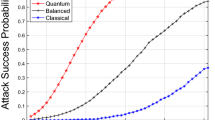Abstract
Securing its networks from cyber-attacks is of utmost importance as the Industrial Internet of Things (IIoT) becomes a lynchpin of contemporary industrial ecosystems. With the increasing complexity and sophistication of cyber threats, traditional machine learning approaches, while successful, frequently struggle with real-time identification due to computational restrictions. In this study, we present an adaptive quantum learning framework for real-time IIoT attack identification that takes advantage of quantum computing’s inherent parallelism and speed. We introduce a novel quantum technique that can quickly and accurately identify both new and existing attack vectors as they emerge in dynamic threat landscapes. The experimental results show improved accuracy rates and a drastic decrease in identification delay compared to classical methods. According to our research, quantum-enhanced learning frameworks have great potential to strengthen IIoT security in the face of more sophisticated cyber-attacks.
Access this chapter
Tax calculation will be finalised at checkout
Purchases are for personal use only
Similar content being viewed by others
References
Paramasivam S, Jenitha J, Sanjana S, Haghparast M (2023) Compact quantum circuit design of PUFFIN and PRINT lightweight ciphers for quantum key recovery attack. IEEE Access 11:66767–66776
Satoh T, Nagayama S, Suzuki S, Matsuo T, Hajdušek M, Meter RV (2021) Attacking the quantum internet. IEEE Trans Quant Eng 2:1–17
Fernández-Caramès TM, Fraga-Lamas P (2020) Towards post-quantum blockchain: a review on blockchain cryptography resistant to quantum computing attacks. IEEE Access 8:21091–21116
Zhang Z, Wu W, Sui H, Wang B, Quantum KA (2022) Shim: attacks on Type-3 generalized Feistel scheme and unbalanced Feistel scheme with expanding functions. IEEE Trans Intell Transp Syst 23(9):209–216
Kumar A (2021) Survey of promising technologies for quantum drones and networks. IEEE Access 9:125868–125911
Kato G, Owari M, Hayashi M (2021) Single-shot secure quantum network coding for general multiple unicast network with free one-way public communication. IEEE Trans Inf Theory 67:4564–4587
Jarzyna M, Jachura M, Banaszek K (2023) Quantum pulse gate attack on IM/DD optical key distribution exploiting symbol shape distortion. IEEE Commun Lett 27:1699–1703
Fernández-Caramés TM (2020) From pre-quantum to post-quantum IoT security: a survey on quantum-resistant cryptosystems for the Internet of Things. IEEE Internet Things J 7(7):6457–6480
Putranto DSC, Wardhani RW, Larasati HT, Kim H (2023) Space and time-efficient quantum multiplier in post quantum cryptography era. IEEE Access 11:21848–21862
Pan D, Li K, Ruan D, Ng SX, Hanzo L (2020) Single-photon-memory two-step quantum secure direct communication relying on Einstein-Podolsky-Rosen pairs. IEEE Access 8:121146–121161
Li Q, Wu J, Quan J, Shi J, Zhang S (2022) Efficient quantum blockchain with a consensus mechanism QDPoS. IEEE Trans Inf Forens Secur 17:3264–3276
Kang X (2023) Patterning-effect calibration algorithm for secure decoy-state quantum key distribution. J Lightwave Technol 41(1):75–82
Sun ZZ, Pan D, Ruan D, Long GL (2023) One-sided measurement-device-independent practical quantum secure direct communication. J Lightwave Technol 41(14):4680–4690
Sutradhar K, Om H (2020) A generalized quantum protocol for secure multiparty summation. IEEE Trans Circuits Syst II Express Briefs 67:2978–2982
Zhonghua C, Goyal SB, Rajawat AS (2023) Smart contracts attribute-based access control model for security & privacy of IoT system using blockchain and edge computing. J Supercomput
Rajawat AS (2023) Enhancing security and scalability of metaverse with blockchain-based consensus mechanisms. In: 2023 15th International conference on electronics, computers and artificial intelligence (ECAI), pp 1–6
Rajawat AS (2023) Blockchain-based security framework for metaverse: a decentralized approach. In: 2023 15th International conference on electronics, computers and artificial intelligence (ECAI), pp 1–6
Goyal SB, Rajawat AS, Solanki RK, Zaaba MAM, Long ZA (2023) Integrating AI with cyber security for smart Industry 4.0 application. In: 2023 International conference on inventive computation technologies (ICICT), pp 1223–1232
Nagaraj S, Kathole AB, Arya L, Tyagi N, Goyal SB, Rajawat AS, Raboaca MS, Mihaltan TC, Verma C, Suciu G (2023) https://doi.org/10.3390/en16010008
Ali MH, Zolkipli MF (2019) Model of improved a kernel fast learning network based on intrusion detection system. In: Vasant P, Zelinka I, Weber GW (eds) Intelligent computing & optimization. ICO 2018. Advances in intelligent systems and computing, vol 866. Springer, Cham. https://doi.org/10.1007/978-3-030-00979-3_15
Zarin I, Akter O, Hosen KS, Islam AU, Hossain S (2023) SWINC: secured wireless intelligent network using cryptography. In: Vasant P, Weber GW, Marmolejo-Saucedo JA, Munapo E, Thomas JJ (eds) Intelligent computing & optimization. ICO 2022. Lecture notes in networks and systems, vol 569. Springer, Cham. https://doi.org/10.1007/978-3-031-19958-5_15
Hossain S, Hasan MM, Rahman MM, Barid M (2022) Factors behind the world crime index: some parametric observations using DBSCAN and linear regression. In: Vasant P, Zelinka I, Weber GW (eds) Intelligent computing & optimization. ICO 2021. Lecture notes in networks and systems, vol 371. Springer, Cham. https://doi.org/10.1007/978-3-030-93247-3_69
Author information
Authors and Affiliations
Corresponding author
Editor information
Editors and Affiliations
Rights and permissions
Copyright information
© 2024 The Author(s), under exclusive license to Springer Nature Switzerland AG
About this paper
Cite this paper
Joshi, P., Goyal, S.B., Rajawat, A.S., Solanki, R.K., Chen, C. (2024). Adaptive Quantum Learning Frameworks for Real-Time IIoT Attack Identification. In: Vasant, P., et al. Intelligent Computing and Optimization. ICO 2023. Lecture Notes in Networks and Systems, vol 1167. Springer, Cham. https://doi.org/10.1007/978-3-031-73318-5_32
Download citation
DOI: https://doi.org/10.1007/978-3-031-73318-5_32
Published:
Publisher Name: Springer, Cham
Print ISBN: 978-3-031-73317-8
Online ISBN: 978-3-031-73318-5
eBook Packages: Intelligent Technologies and RoboticsIntelligent Technologies and Robotics (R0)




